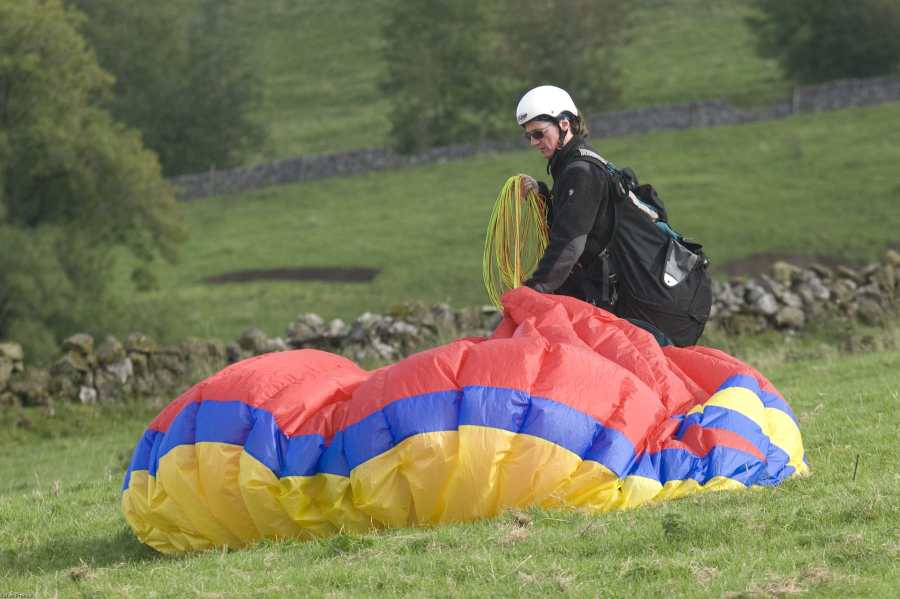Outdoor Ed – currently touring Britain with a new show – takes to the skies in his regular column for The Great Outdoors
Ed Byrne is currently touring Britain with his new show, Spoiler Alert, as part of which he shares some hilarious insights into the trips he’s made into the hills for The Great Outdoors magazine. To celebrate, we are publishing one of his archive features each week as a treat for Ed’s fans and readers of The Great Outdoors. Look out for the November issue of the magazine for his next one. Enjoy!
Outdoorsy people are a very tribal breed, don’t you think? We seem to subdivide into groups and those groups can sometimes be quite judgemental towards each other. Many of us are guilty of snobbishness when coming into contact with people who dare to enjoy the outdoors in a way that is even slightly different to our own: rock climbers looking down on hillwalkers; hillwalkers angry at mountain bikers; mountain bikers fed up with quad bikers. Some of these rivalries are completely understandable, particularly when one activity threatens the safety of someone engaged in another. Some of the animosity is just silly though. The parochial, gang-like mentality of a skier and a snowboarder coming to blows over whose is the better way to slide down a hill is an abject lesson in pettiness. Or, for a textbook example of hair-splitting, peak-baggers vs non peak-baggers. I’ve genuinely had people look down on me or try to start an argument because they believe peak-baggers don’t enjoy a walk for the sake of the walk and therefore aren’t enjoying the mountain properly. “I don’t see what the appeal is of ticking a mountain off.” Maybe not, but you certainly see the appeal of ticking ME off!
Even with all this tribalism and rivalry there’s one group that I’ve never heard anybody else complain about or be dismissive of. Maybe it’s just the people I’ve come across but I’ve never seen anyone tut, shake their head and say, “Bloody paragliders”. I could be wrong. Maybe you hate paragliders. Maybe you were trying to enjoy nice wild camp and one accidentally landed on your tent, but I’ve always viewed paragliders with a mixture of awe and envy. Whenever I’ve come across paragliders on my travels, whether it’s been on Mont Blanc in Chamonix or Mount Maunganui in New Zealand or Black Hill in Herefordshire, they’ve always stopped me in my tracks and made me think, “One day…”
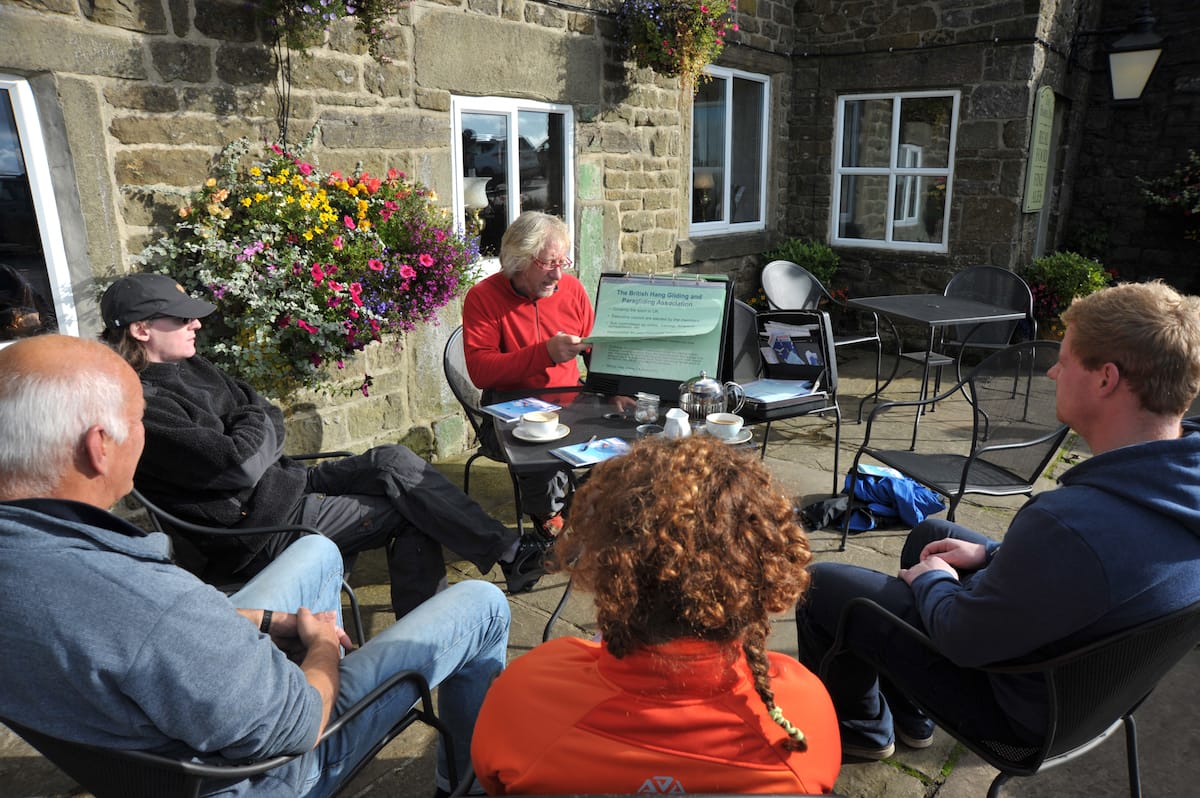
Well, that one day finally came a couple of weeks ago on a gentle slope on some farmland just outside Buxton. It may not have the majesty of the French Alps or the coastal vista of NZ’s North Island but you have to start somewhere. Like many flying schools, the Derbyshire Flying Centre offers a one-day taster session to see if you fancy paragliding. It begins with a briefing, sitting outside a pub across the road from a bench erected in memory of a paraglider who died doing what he loved. It’s a sober reminder that what we were about embark upon is not without risk. If we want another reminder, Steve, our instructor, offers to show us the scar from the time he broke his neck.
Steve is an incredibly youthful looking 60-year-old with a natty line in eyewear. He talks us through some of the theory involved before we all decamp to the field where we’ll be taking our maiden flights. It’s not everybody’s maiden flight. Will – who’s in his twenties – and I are the only virgins. Collette, who is my age, has done this once before, Stephen, a maths lecturer, is now into his ninth hour of flying and retired pharma exec David, although new to paragliding, is an experienced hang glider pilot.
I was only a few feet above terra firma but all I wanted was to keep going higher and never come down
The short walk to our launch site is easier than I expected. The combined wing and its seat are no heavier than the pack you’d carry on a multi-day backpacking trip, provided you like a bit of comfort while you’re camping. As the more experienced pilot, Stephen starts from a few metres further up the hill. The rest of us line up below him and Steve shows us how to unpack, lay out and then strap into the wing. The wing itself is a feat of modern engineering: a myriad of coloured threads attached to a series of baffles, divided into cells by little ribs. I takes just a quick pull on the left and right brake line and a couple of steps forward to inflate the wing and have it hovering over my head. Steve instructs me to run down the hill and, before I even take a step, he is pushing me from behind. I take just a scant few strides and I am airborne. At this point, I fully expected I would panic. I’m not exactly an adrenaline junky. If I’m going downhill on a bike I’ll maintain a vice-like grip on the brake the whole way. I’m also not great with heights, which has curtailed the bulk of my rock climbing ambitions. Between these two traits, I was seriously worried that as soon as I left the ground I would scream like a boiled child and bring myself back to earth immediately.
 Instead I was utterly exhilarated. I was flying and it felt fantastic. Obviously, part of the reason I was panic-free was the fact that I was really only a few feet above terra firma and not travelling terribly fast, but in that moment all I wanted was to keep going higher and never come down. Steve started barking instructions at me through a radio he’d pinned to my chest, telling me when to pull the brakes to ensure a soft landing. My touchdown was perfect and as the wing fell to the ground behind me Steve came running down to show me how to pick it up and carry it back up the hill. Unfortunately, I was so excited about what I’d done, I didn’t pay much attention. This meant that the next few goes were marred by my rather haphazard attempts to bundle up my wing and cart it back to the launch area.
Instead I was utterly exhilarated. I was flying and it felt fantastic. Obviously, part of the reason I was panic-free was the fact that I was really only a few feet above terra firma and not travelling terribly fast, but in that moment all I wanted was to keep going higher and never come down. Steve started barking instructions at me through a radio he’d pinned to my chest, telling me when to pull the brakes to ensure a soft landing. My touchdown was perfect and as the wing fell to the ground behind me Steve came running down to show me how to pick it up and carry it back up the hill. Unfortunately, I was so excited about what I’d done, I didn’t pay much attention. This meant that the next few goes were marred by my rather haphazard attempts to bundle up my wing and cart it back to the launch area.
Two things that I hate having to do are untangling wires and putting covers on duvets. Sorting out a messed-up paragliding wing can best be expressed mathematically as: untangling wires to the power of putting a cover on a duvet. These frustrations pale, however, when endured between bouts of actual, feet off the ground, honest to goodness flight! After a few more goes I start to get the hang of gathering the wing up by its lines and the closest thing to hardship is walking up the hill while still strapped into the seat. This makes you feel a bit like a cartoon tortoise walking on its hind legs.
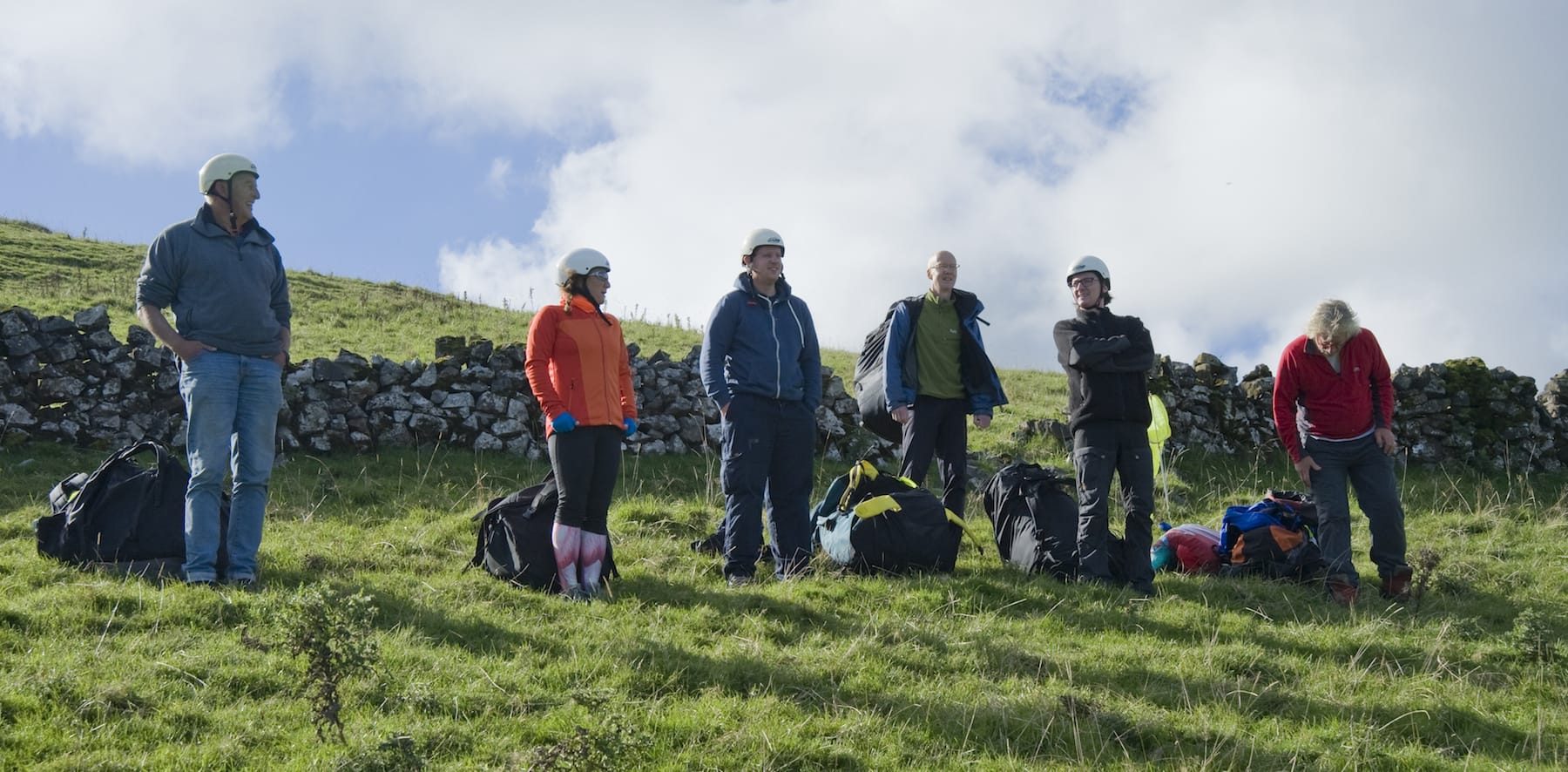
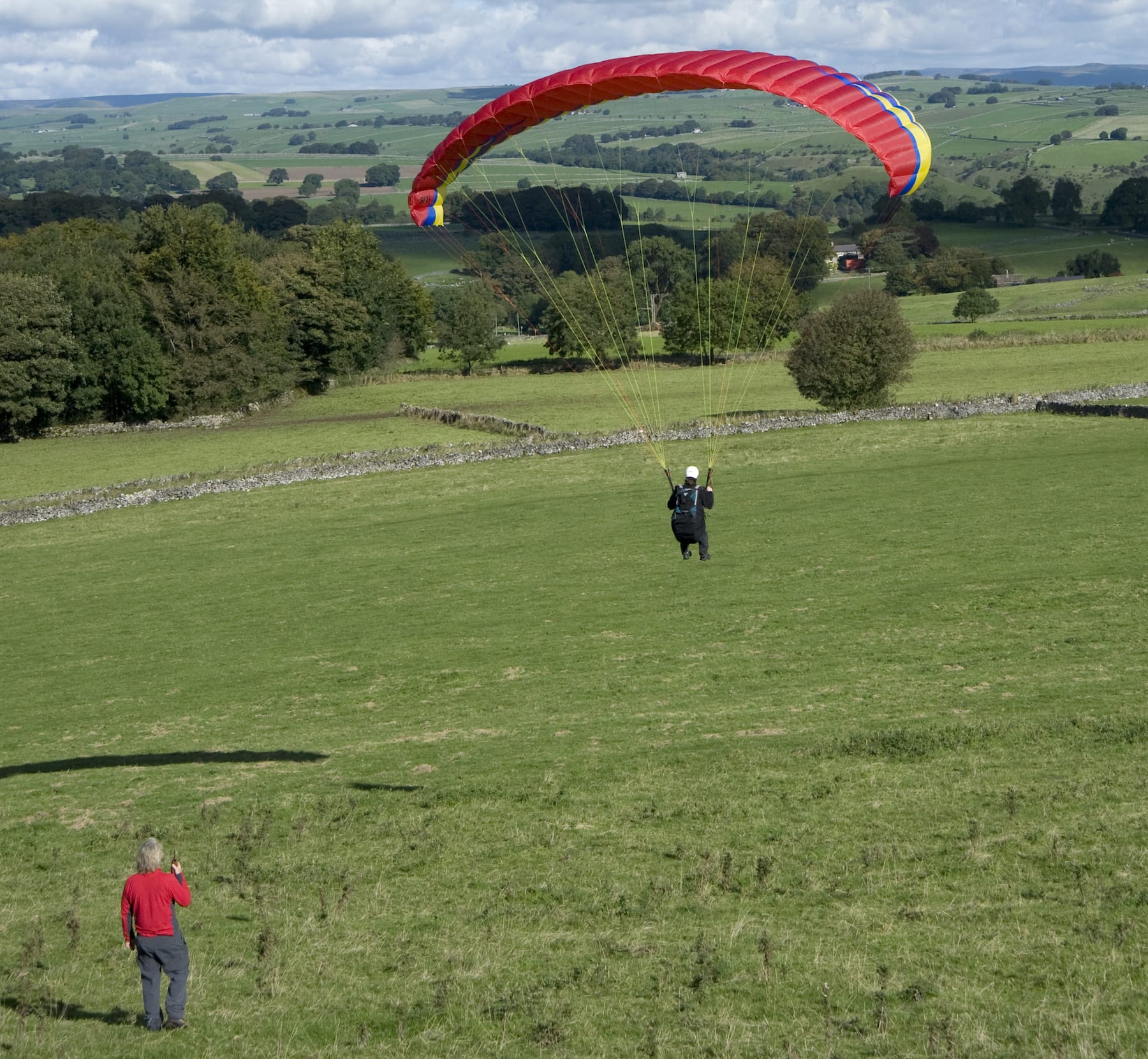
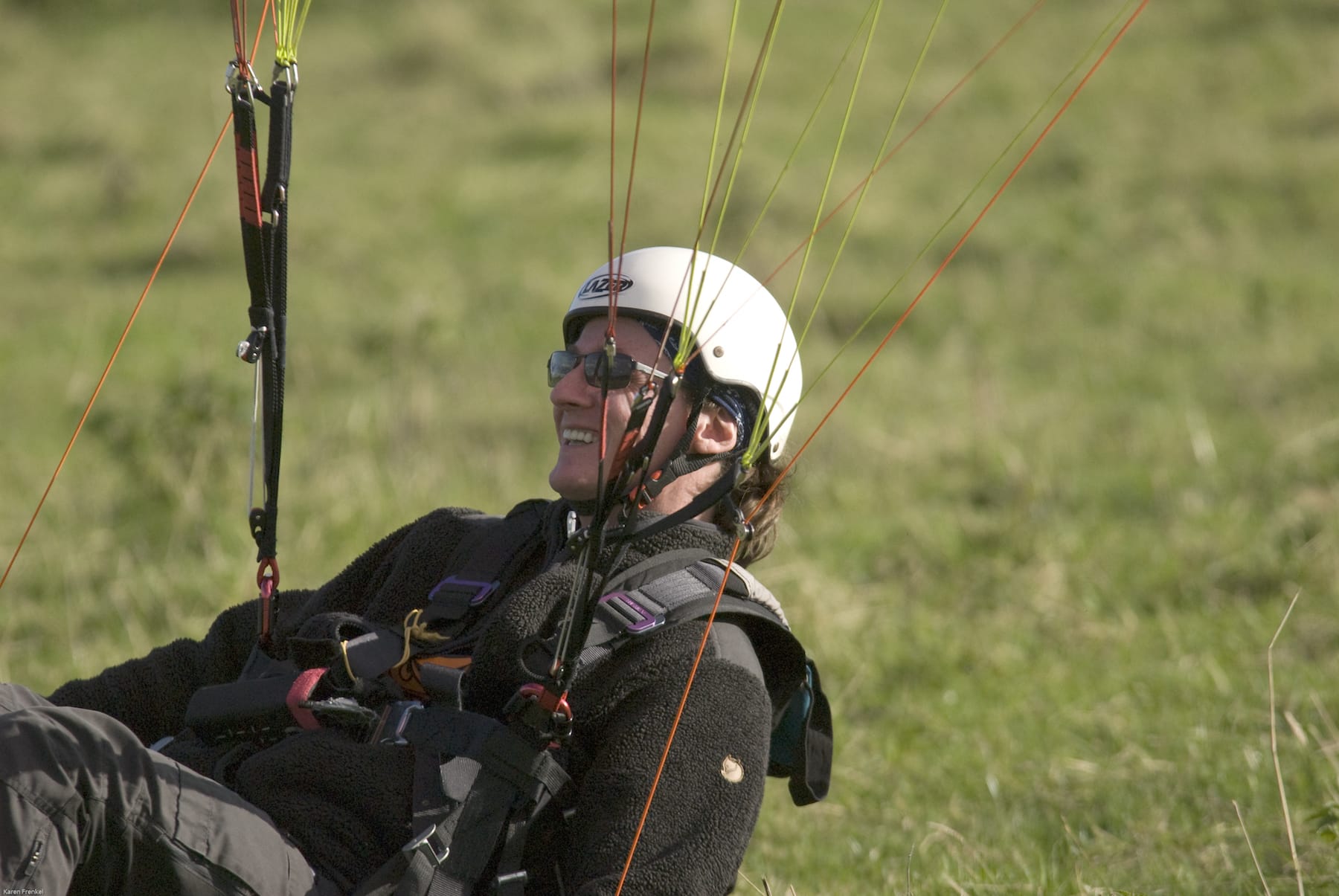
Towards the end of the lesson, just as the novelty of such a repeatedly short flight was beginning to wear off, Stephen, who had been having mixed fortunes most of the day, caught the wind just perfectly. He sailed over our heads and wound around the field in a figure of eight as we cheered him on. It was the perfect demonstration of what we beginners would be doing after just a few more lessons. I think I speak for all of us when I say we’ll all be giving it another go.
As I sat on that gentle slope, waiting for the wind to be just right for one last launch, fantasising about swooping through the French Alps, my dreams of multi-day paragliding adventures were drowned out by the roar of a particularly noisy motorbike that couldn’t have been doing more than about 40 miles an hour but sounded like a Formula 1 car going full pelt. I thought, “What a ridiculous amount of noise to make to go that speed along the A6. Doesn’t he realise he could be FLYING and hardly making a sound if he wanted to?” and the reason I thought that is because I am a snobby, judgemental, tribal, superior arsehole, and I’m really into paragliding now.
The Derbyshire Flying Centre offers training in both paragliding and hang gliding. For more information, check out the website at d-f-c.co.uk or call Steve on 01298 872313 or 07762729663.
This feature was first printed in The Great Outdoors, December 2016.
All images © Karen Frenkel

